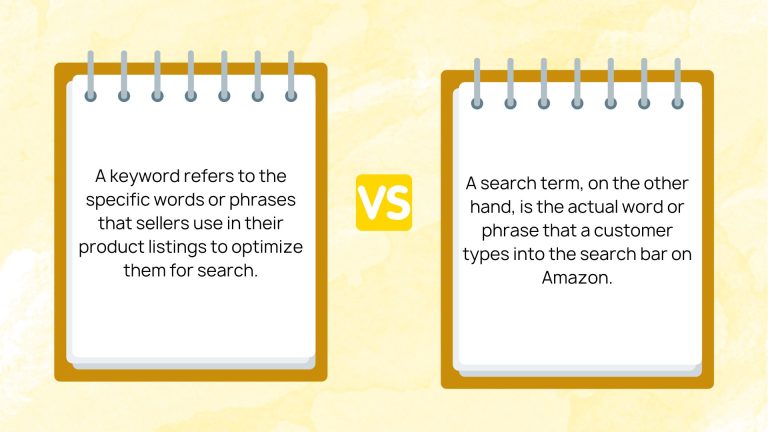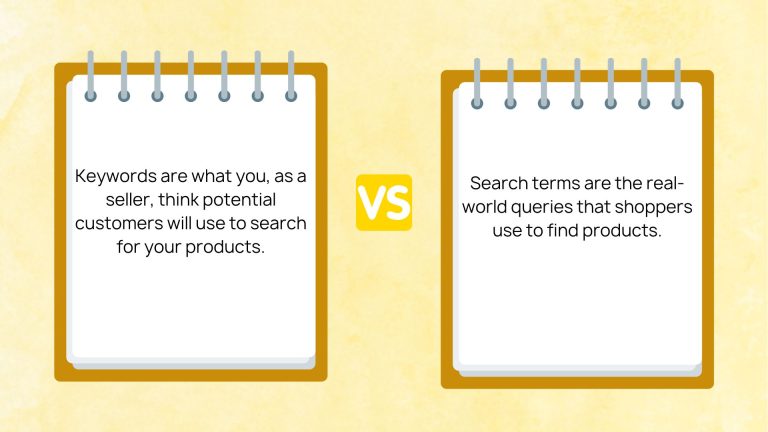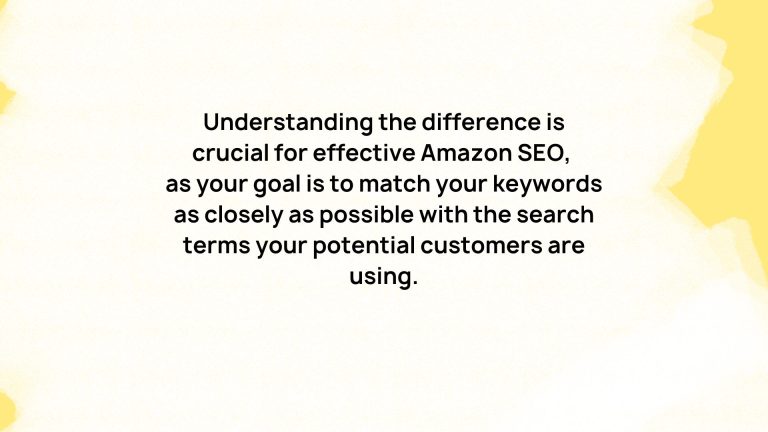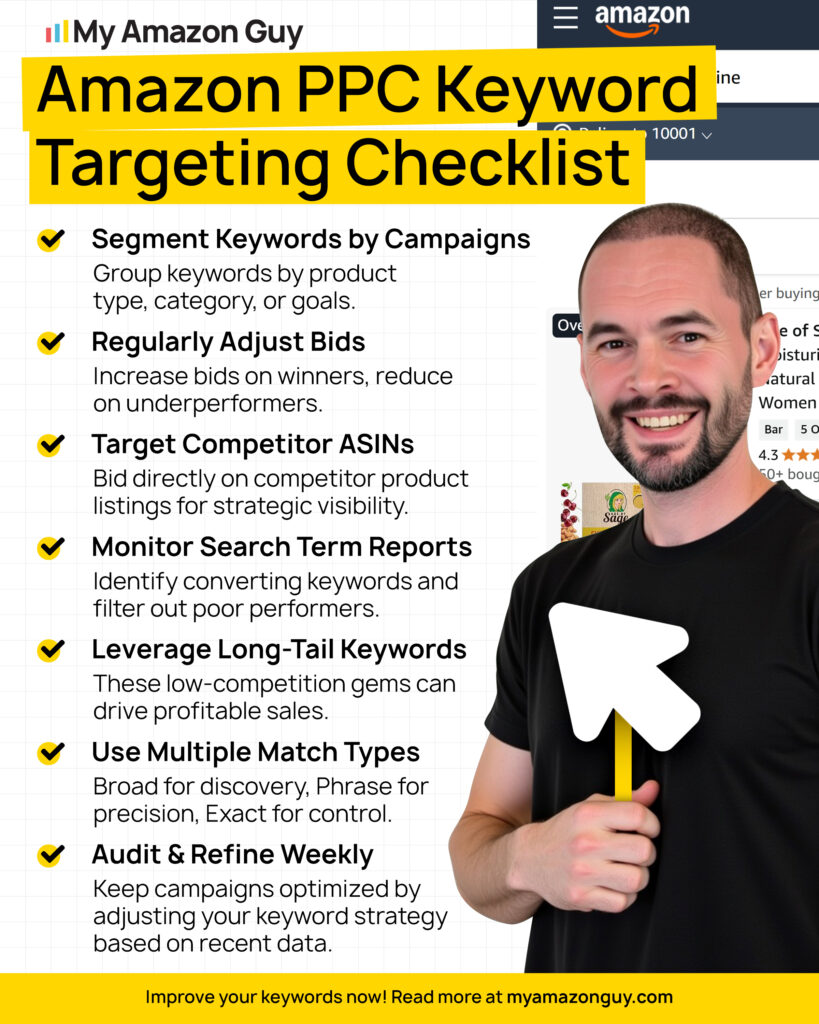Last Updated: May 30, 2025
Having trouble figuring out which keywords to use in your Amazon listings? That’s exactly why knowing how to find Amazon keywords is non-negotiable when you decide to sell on Amazon.
Optimizing your listings is one of the biggest parts of selling on Amazon if you want to get more clicks and sales. But it’s not as easy as stuffing random words in your Amazon listings; there’s a strategy behind it, and it starts with keyword research.
Finding the right keywords is how your products show up in front of actual buyers, not just browsers. The better your keywords, the better your chances of ranking, converting, and scaling.
In this blog post, our Amazon agency will break down how to find Amazon keywords that actually work. From research tools to backend tips to competitor spying, we’ll walk you through everything you need to boost your visibility and sales.
Table of Contents
How To Find Amazon Keywords: What are Amazon Keywords?
Amazon keywords are the words and phrases shoppers type into the search bar when looking for products. Sellers use these keywords in their listings so their products show up in relevant search results.
If you’re selling a stainless steel water bottle, keywords like “metal water bottle” or “insulated flask” can help you rank. The right keywords boost your visibility, drive traffic, and increase your chances of making a sale.
How Important Are Amazon Keywords
There are several reasons why sellers should use Amazon keywords. Here they are:
- Keywords are the primary way customers discover products on Amazon.
- Relevant keywords directly contribute to increased product sales.
- Effective keyword usage improves your product’s search ranking on Amazon.
- Proper keywords enable you to target your ideal customers more effectively.
- Keywords are essential for successful Amazon advertising campaigns.
- Strategic keyword use attracts highly targeted traffic to your listings.
- Optimizing for keywords is a cost-effective marketing strategy.
- Utilizing the right keywords provides a significant competitive advantage.
What Is the Difference Between a Keyword and a Search Term?
In the context of Amazon and e-commerce, the terms “keyword” and “search term” are often used interchangeably, but they do have distinct meanings:




How To Find Amazon Keywords: Using Keyword Research Tools for Amazon SEO
Finding Amazon keywords can be difficult if you decide to do it manually. Good thing there are keyword research tools you can use that make the job easier and help improve your Amazon SEO.
How Do I Increase My Search Results on Amazon Through Keywords?
Increasing your search results on Amazon through keywords involves finding and strategically using the right keywords in your product listings. Here are some steps to follow:
- Conduct Keyword Research
- Optimize Your Product Title
- Use Keywords in Bullet Points and Product Description
- Backend Keywords
- Avoid Keyword Stuffing
- Regularly Review and Update Keywords
We will discuss these steps more below. Meanwhile, here is a video from our full-service Amazon agency explaining how to dominate the Amazon Search Page:
How Do I Find High-Ranking Keywords on Amazon?
Finding high-ranking keywords on Amazon involves a combination of research and the use of specialized tools. Here are some strategies you can use to do it:
- Amazon Autocomplete
Start typing a keyword related to your product in Amazon’s search bar and see the suggestions provided. These are often high-ranking keywords. - Look at Competitors
Check the listings of top-selling products that are similar to yours. Look at the keywords they use in their titles, descriptions, and bullet points. - Use Keyword Tools
Tools like Helium 10, Jungle Scout, or AMZ Scout can help you find high-ranking keywords. They have features that show keyword search volume, competition, and potential profitability. - Check “Customers who bought this also bought”
This section on Amazon product pages can give you ideas about related keywords. - Analyze Your PPC Data
If you’re running Amazon PPC campaigns, your Search Term Report can provide valuable insights into which keywords are performing well for your products.
Top Keyword Research Tools for Amazon Sellers
The fact is, the best Amazon keyword research tool for you will depend on your specific needs and budget. Still, there are tools proven to be helpful by experts, and learning about them can give you a good idea of what’s worth trying out.
- Helium 10
This is a comprehensive tool for Amazon sellers, providing keyword research, product research, listing optimization, and more. - Jungle Scout
It’s known for its product research capabilities, but it also offers a powerful keyword research tool. - AMZ Scout
This tool provides a suite of features, including keyword research, product tracking, and sales estimations. - Viral Launch
It offers a suite of tools for Amazon sellers, including keyword research, listing optimization, and product discovery. - Merchant Words
This helps sellers access a vast database of shopper search terms, offering insights into keyword trends and customer behavior.
How to Use Keyword Research Tools Effectively
Knowing how to effectively use an Amazon keyword research tool is important since no tool can make a difference if you don’t know how to use it correctly. Below are the steps to help you make the most out of your keyword research and get better results for your listings.
Step 1: Identify Relevant Keywords
Start by identifying keywords that are relevant to your product. You can use the tool’s search function to find similar phrases and terms related to your product.
Step 2: Analyze Search Volume
The tool shows the estimated monthly search volume for each keyword. Prioritize keywords with high search volumes as these are the terms most customers are using to find products like yours.
Step 3: Understand Your Competition
The tool provides data insights like organic and sponsored ranks for each keyword. This can help you understand how your competitors are performing and where you can improve.
Step 4: Filter Your Keywords
Use the tool’s filtering options to narrow down your keyword list. You may want to focus on niche markets or filter by search volume to focus on the most popular searches.
Step 5: Export Your Keywords
Most tools allow you to download your keyword list to a CSV file. This can be useful for further analysis and for keeping track of your keyword strategy.
Step 6: Test and Adjust
Keyword research should not be done only once. Monitor your performance, test different keywords, and adjust your strategy as needed.
Analyzing Keyword Data from These Tools
After finding the right keywords, the next thing to do is analyze them so you can use them properly in your Amazon listings and PPC campaigns. Understanding the data behind each keyword helps you decide which ones are worth keeping and where to place them.
- Review Relevancy Score
The relevancy score indicates how relevant a keyword is to your product. A high score suggests that the keyword is likely to lead to conversions. - Look at Estimated Monthly Search Volume
This gives an idea of how often a keyword is searched for on Amazon in a month. A high search volume indicates that a keyword is popular among Amazon customers. - Analyze Organic and Sponsored Ranks
These ranks show how well your product or a competitor’s product is ranking for a keyword organically and in paid placements. This gives you an idea of the competition level for a keyword. - Consider Niche Markets
The tool can help identify niche markets that could be profitable. Keywords with lower search volume but high relevance to your product can indicate a niche market. - Export Data for Further Analysis
Most tools offer the option to download keyword data to a CSV file. This allows you to do deeper analysis, track changes over time, and integrate the data with other tools or datasets you might be using.
Below are some videos you can watch to learn more about Amazon keyword research:
How To Find Amazon Keywords: Using Keywords To Optimize My Listing
Even if your product is the best of the best and priced just right, it won’t sell if it doesn’t show up in front of potential customers. That’s why it’s important to optimize your listings with the right keywords so your product actually gets found.
Best Practices for Amazon Keyword Placement
There are various locations where you can place keywords to properly optimize your listings. Each one plays a specific role in indexing and ranking, so knowing their purpose helps you decide which keywords to use and where.
- Product Title
Incorporate important keywords in the product title. This is the first place Amazon looks to understand what your product is. Make sure your product title is clear, concise, and contains the most relevant keyword. - Product Description and Bullet Points
Use these areas to include additional keywords. Provide detailed and accurate information about the product while naturally inserting keywords. - Backend Keywords
Amazon allows you to enter hidden keywords in the backend. Use this space for synonyms, abbreviations, alternate names, etc. that you couldn’t fit into the title or bullet points. - Product Grid
As per the information from the database, you can also place keywords on the product grid. Cross-compare products and click on other related items to optimize keyword placement. - Use Keyword Research Toolkits
Use Amazon keyword research tools to find the best keywords for your product. These tools can provide insights into the most popular search terms and help you optimize your listing. - Avoid Keyword Stuffing
While it’s important to include relevant keywords, avoid “stuffing” your listing with keywords in a way that makes the text unnatural or hard to read. Amazon could penalize listings that engage in this practice.
Is It Better to Have More or Fewer Keywords in My Amazon Listing?
When it comes to keywords in your Amazon listing, focus on relevance and strategic placement instead of cramming in as many as possible. Stuffing irrelevant or excessive keywords can make your listing look spammy and may even hurt your search ranking.
Instead, use high-ranking, relevant keywords in key areas like the title, bullet points, description, backend, and product grid. This approach improves indexing, keeps your listing natural, and avoids penalties from Amazon’s algorithm.
Does the Order of Keywords Matter?
Yes, the order of keywords does matter when optimizing your Amazon listing. Placing your most important keywords toward the beginning of your title, bullet points, and description can improve your chances of ranking higher.
That said, your listing should still read naturally, so avoid awkward phrasing or keyword stuffing. Relevance and readability go hand-in-hand when it comes to effective keyword placement.
Does Amazon Penalize Keyword Stuffing?
Yes, Amazon does penalize keyword stuffing in listings. This happens when keywords are used excessively or unnaturally, making your content feel spammy rather than helpful.
To avoid this, use keywords in a way that feels natural and adds value to your listing. Focus on relevance, clarity, and readability to boost both your ranking and customer experience.
How Many Keywords Are Allowed Per Amazon Listing?
There’s no fixed limit to how many keywords you can include in an Amazon listing, but quality matters more than quantity. Focus on using targeted, relevant, and high-converting keywords instead of cramming in as many as possible.
While there is no set number, it’s generally advised to focus on 2-3 primary keywords in your product title and then strategically include additional relevant keywords in the bullet points and product description. Remember to prioritize readability and ensure that your listing flows naturally for potential customers.
How Many Times Should You Use Your Keyword?
There’s no magic number for how often you should use a keyword in your Amazon listing. Instead of worrying about keyword density, focus on writing high-quality, relevant content that flows naturally.
Make sure your main keywords show up in key areas like the product title, bullet points, and description, but don’t force them in. Use them where they make sense and always prioritize clarity and accuracy for your customers.
How To Find Amazon Keywords: Types of Keywords on Amazon
On Amazon, there are different types of keywords that sellers can consider for optimizing their product listings. Here are some common types of keywords on Amazon:
Primary Keywords
Primary keywords are the main keywords that describe your product and the product’s core features. They are typically included in the product title and play a crucial role in determining your product’s visibility in search results.
Long-Tail Keywords
These are longer, more specific keyword phrases that target a niche or specific customer searches. Long-tail keywords often have lower search volume but can be highly relevant and have less competition, allowing for better visibility and conversion rates.
Competitor Keywords
These are keywords that are related to your product and are frequently used by your competitors. Analyzing competitor listings can help you identify relevant keywords that you may not have considered.
Backend Search Terms
These are additional keywords that you can include in the backend search term fields of your Amazon listing. Backend search terms are not visible to customers but can help improve your listing’s discoverability for specific search terms.
Seasonal Keywords
These are keywords that are relevant for specific seasons or holidays. Optimizing your listing with seasonal keywords can help attract customers during specific periods when demand for certain products is higher.
Brand Keywords
These are keywords that specifically include your brand name or variations of it. Brand keywords can help strengthen your brand presence on Amazon and attract customers who are specifically searching for your brand.
What Is a Primary Keyword in Amazon?
Just as previously stated, primary keywords are the main search terms that best describe your product and what it offers. But aside from that, primary keywords are also what you want your product to rank for when shoppers type them into the Amazon search bar.
They’re usually placed in the product title because that’s where they carry the most weight in terms of search visibility. Choosing the right one means understanding your customers, analyzing competitors, and picking the keyword that accurately reflects your product and drives relevant traffic.
What Are Keyword Attributes in Amazon?
Keyword attributes in Amazon are additional pieces of information that you can provide about your product keywords. These attributes can help Amazon to better understand your products and to match them with relevant customer searches.
When you add keyword attributes to your product listings, you are helping Amazon to better understand your products and to match them with relevant customer searches. This can lead to increased visibility for your products and more sales.
What Are Amazon Backend Keywords?
Backend keywords on Amazon are hidden search terms that help boost your product’s visibility without being seen by customers. They’re placed in the backend of your listing and are indexed by Amazon’s algorithm to help your product appear in more relevant searches.
To use them effectively, keep your entries under 2500 characters, avoid repeating front-end keywords, and skip special characters. Use variations, synonyms, and alternate spellings that are highly relevant to your product, and never include prohibited or misleading terms.
How To Find Amazon Keywords: Amazon Auto-Suggest Feature and Search Term Report
Amazon keyword research tools are very helpful for sellers since they can provide valuable data to help identify high-ranking keywords, but not everyone has the budget for them. If that’s the case, Amazon’s own auto-suggest feature and search term reports can also give you keyword insights straight from customer behavior.
How Amazon Auto-Suggest Works
Amazon’s auto-suggest feature is designed to provide users with real-time suggestions as they type in the search bar. Here’s how Amazon’s auto-suggest works:
- User Input
When a user starts typing a query in the search bar on Amazon, the auto-suggest feature is triggered. - Algorithm
Amazon uses a complex algorithm to generate auto-suggestions based on various factors, including search volume, popularity, relevance, and recent customer behavior. - Popularity and Search Volume
The auto-suggest feature takes into account the popularity and search volume of specific keywords. It suggests commonly searched terms to help users find what they are looking for more quickly. - Relevance
Amazon’s auto-suggest also considers the relevance of keywords to the user’s search query. It suggests keywords that are closely related to the user’s input and have a higher chance of leading to relevant search results. - Customer Behavior
The auto-suggest feature takes into account customer behavior and trends. It considers the search history and purchase behavior of previous users to provide relevant suggestions based on what other customers have searched for or purchased. - Product Listings
The auto-suggest feature also considers the product listings available on Amazon. It suggests keywords that are commonly associated with a wide range of products to help users explore different options.
Best Practices for Getting Keyword Ideas from Auto-Suggest
Getting keywords from the auto-suggest feature might seem easy since it only takes a few simple steps, but if you’re not doing it right, how can you be sure the keywords will actually help? That’s why it’s important to follow best practices when using Amazon’s auto-suggest to make sure the keyword ideas you gather are effective and relevant.
- Start with a Seed Keyword
Begin by entering a relevant seed keyword related to your product or niche into the Amazon search bar. - Observe Auto-suggestions
As you type, take note of the auto-suggestions that appear. These suggestions are based on popular and frequently searched terms related to your seed keyword. - Expand Keyword Variations
Analyze the auto-suggestions and identify variations, long-tail versions, or related keywords that may be relevant to your product. These variations can help you target a broader range of search terms. - Analyze Competition
Take note of the auto-suggestions that appear for products similar to yours. This can give you insights into the keywords your competitors are targeting and help you identify potential gaps or opportunities. - Consider Related Categories
Auto-suggestions may also provide keywords related to specific categories or subcategories. Explore these suggestions to discover additional relevant keywords that you may have overlooked. - Use Third-Party Tools (If You Can)
To further expand your keyword research, consider using third-party keyword research tools. These tools can provide additional keyword suggestions and insights to enhance your keyword optimization efforts.
How Can the Search Term Report Be of Use?
The Amazon Search Term Report gives sellers direct insight into the actual search terms customers used to find and buy their products. You can access it in Seller Central under “Advertising Reports,” where you can generate the report to see which keywords led to clicks and sales.
While this report is helpful, it has limitations in how many terms it shows and the depth of data it provides. That’s why many sellers also use third-party tools for deeper keyword research and better optimization strategies.
Find out more about the Search Term Report in this video:
How To Find Amazon Keywords: Leveraging Competitor Analysis for Keyword Discovery
Part of finding the right keywords for your Amazon listing is analyzing your competitors, since this shows you what’s helping their products rank and drive sales. It also speeds up your process by giving you a focused list of keywords to target instead of guessing blindly.
Here’s how you can use competitor analysis to discover valuable keywords:
- Identify Competitors
Begin by identifying your main competitors on Amazon. Look for products that are similar to yours and have a high level of competition. - Analyze Competitors’ Amazon Listings
Study the product listings of your competitors. Look at their product titles, bullet points, and product descriptions, check the keywords they are targeting, and how they have optimized their listings. - Look Into Their Backend Keywords
Examine the backend keywords of your competitors. While backend keywords are not visible to customers, you can view the HTML source code of their product listing page to find hidden keywords. This can give you insights into the keywords they are targeting for indexing purposes. - Observe PPC Campaigns
Monitor your competitors’ sponsored ad campaigns. Look for keywords they are bidding on and targeting in their advertising efforts. This can help you identify high-performing keywords that are driving traffic and conversions for them. - Utilize Keyword Research Tools
Consider using third-party keyword research tools. These tools can provide valuable insights into the keywords your competitors are targeting and suggest related or alternative keywords that you may not have considered. - Analyze Customer Reviews
Read customer reviews of your competitors’ products. Look for keywords and phrases that customers repeatedly mention. This can uncover additional keywords that are relevant to your product or niche. - Stay Updated
Continuously monitor your competitors’ listings and strategies. Keep an eye on any changes they make to their keywords, product features, or pricing. This will help you stay competitive and adapt your keyword strategy accordingly.
Can You Use Competitor Names in Amazon Keywords?
No, using competitor brand names in your Amazon keywords is generally not recommended. Amazon’s policies prohibit including competitor names in a way that might mislead or confuse shoppers.
Adding competitor brand names in your backend keywords could lead to policy violations and risk having your listing suppressed or removed. Instead, focus on keywords that accurately describe your own product and its unique benefits to attract buyers on its own merits.
How To Find Amazon Keywords: The Role of Long-Tail Keywords in Amazon SEO
Long-tail keywords play a crucial role in Amazon SEO by targeting more specific and less competitive search terms. Using these keywords helps sellers reach highly interested customers who are closer to making a purchase.
What Are Long-Tail Keywords?
Long-tail keywords on Amazon are more specific search terms that usually have lower search volume but higher purchase intent. Unlike broad keywords, they often include three or more words and focus on capturing the exact needs or preferences of shoppers.
Here are a few characteristics of long-tail keywords on Amazon:
- Specificity
Long-tail keywords are highly specific and descriptive, often including details about the product’s features, attributes, or use cases. For example, instead of using a broad keyword like “shoes”, a long-tail keyword could be “women’s running shoes with arch support”. - Lower Competition
Long-tail keywords typically have lower competition compared to broader keywords. This can make it easier to rank higher in search results and increase visibility for your product. - Higher Conversion Potential
Long-tail keywords often indicate a more specific and intentional search intent. Shoppers using long-tail keywords are usually closer to making a purchase decision, resulting in higher conversion rates. - Improved Relevance
Long-tail keywords help to improve the relevance of your product listing by aligning with the specific needs and preferences of your target audience. This can lead to more qualified traffic and better engagement with your listing. - Better Targeting
By incorporating long-tail keywords into your product listing, you can reach a more targeted audience that is actively searching for specific features or benefits. This can result in higher-quality traffic and a higher likelihood of converting into sales.
Strategies for Finding Relevant Long-Tail Keywords
Finding relevant long-tail keywords for your Amazon listing involves a combination of research and understanding your target audience. Here are some strategies to help you discover and identify relevant long-tail keywords:
- Brainstorming
Think about specific features, use cases, benefits, or variations that customers may search for. Consider different angles and perspectives that your target audience might have when looking for products like yours. - Use Amazon Autocomplete
Start by typing a relevant term related to your product and see what auto-populates in the search bar. These suggestions can give you insights into popular long-tail keywords that people are searching for. - Check Competitor Listings
Study the product listings of your competitors, especially those who are performing well. Look for long-tail keywords they are using in their titles, bullet points, and product descriptions to give you ideas for relevant long-tail keywords to incorporate into your own listing. - Read Customer Reviews
Look for specific phrases, keywords, or features that customers mention repeatedly. These insights can help you identify long-tail keywords that align with customer preferences and search intent. - Keyword Research Tools
Take advantage of third-party keyword research tools that can provide valuable data and suggestions for long-tail keywords related to your product. They often provide search volume, competition level, and other key metrics to help you assess the relevance and potential of each keyword. - Leverage Amazon Search Terms Report
If you already have an active Amazon listing, analyze your own search terms report. Look for longer, more specific search terms that have generated clicks or sales, as these can be potential long-tail keywords. - Use Google Keyword Planner
While Amazon is the primary platform, don’t forget about Google. Use Google Keyword Planner to explore relevant long-tail keywords that are popular in web searches, since these keywords can often be applied to your Amazon listing as well.
How To Find Amazon Keywords: Keywords for Effective Advertising
Including keywords isn’t just for your Amazon listings; you also need them to make sure your PPC campaigns show up for the right shoppers. Below are the best practices when choosing the keywords for your Amazon ads:
- Choose keywords that are highly relevant to your product by ensuring that the keywords accurately describe your product’s features, benefits, and use cases. This helps you reach the right audience who is more likely to be interested in your product.
- Consider the search volume of keywords to gauge their popularity and potential reach. Use tools like Amazon Advertising’s Keyword Planner or third-party keyword research tools to identify keywords with a good balance of search volume and relevance.
- Evaluate the competition level of keywords to assess the level of competition you may face when bidding on them. Highly competitive keywords may have higher CPC, so it’s important to find a balance between relevance and competition.
- Incorporate long-tail keywords into your advertising campaigns since long-tail keywords are more specific and targeted, and they often have lower competition. They can help you reach a more qualified audience and increase the chances of conversions.
- Utilize negative keywords to exclude irrelevant search terms from triggering your ads. because this helps you avoid wasting ad spend on clicks from users who are unlikely to convert. Regularly review your search term reports to identify negative keywords and refine your campaign targeting.
- Experiment with the different keyword match types available in Amazon advertising. Broad match, phrase match, and exact match allow you to control the level of precision in targeting.
- Continuously monitor the performance of your advertising campaigns and optimize your keyword selection based on data-driven insights. Regularly review your ad performance metrics, including CTR, conversion rate, and ROAS, to identify areas for improvement.
- Test different variations of keywords and track their performance. This can help you identify high-performing keywords that drive better results.
- Amazon offers different advertising formats like Sponsored Products and Sponsored Brands. Utilize these formats to target specific keywords and increase your visibility in search results.
How To Find Amazon Keywords: Keyword Performance
When it comes to evaluating keyword performance on Amazon, there are several key metrics to consider. These metrics can provide insights into how well your keywords are performing and help you make data-driven decisions to optimize your listings and advertising campaigns.
Here are some important keyword performance metrics on Amazon:
- Search Volume
Search volume refers to the number of times a keyword is searched for on Amazon. Higher search volume indicates higher demand for a particular keyword, while lower search volume suggests lower demand. - Click-Through Rate
CTR measures the percentage of users who click on your listing after seeing it in search results. It is an important metric to evaluate the effectiveness of your keywords in generating interest and driving traffic to your listing. - Conversion Rate
The conversion rate measures the percentage of users who make a purchase after visiting your listing. A higher conversion rate indicates that your keywords are effectively targeting the right audience and attracting interested buyers. - Advertising Cost of Sales
ACoS is a metric specific to Amazon advertising campaigns that measures the ratio of your ad spend to the sales generated from those ads. A lower ACoS indicates better keyword performance, as it means you are generating more sales for every dollar spent on advertising. - Return on Ad Spend
ROAS measures the revenue generated from your ads compared to the cost of those ads. A higher ROAS indicates better keyword performance, as it means you are generating more revenue for every dollar spent on advertising. - Keyword Rank
Keyword rank refers to the position of your listing in search results for a specific keyword. Higher keyword rankings indicate better performance, as your listing is more likely to be seen by potential customers.
How to Monitor Amazon Keyword Performance
Monitoring keyword performance on Amazon is essential for optimizing your listings and advertising campaigns. Here are several ways to effectively monitor keyword performance on Amazon:
- Utilize Amazon Advertising’s campaign reports to gather valuable data on keyword performance. These reports provide insights into metrics like impressions, clicks, conversions, and ACoS for each keyword in your campaign.
- Analyze the search term reports to identify relevant keywords that are driving conversions and optimize your keyword strategy accordingly. Pay attention to search terms with high conversion rates and consider adding them as keywords to your campaigns.
- Use Amazon Seller Central analytics tools to get data on sales, traffic, and conversion rates for specific keywords. Use these reports to track the performance of your keywords over time and make data-driven decisions.
- Consider using third-party tools designed for Amazon keyword tracking. These tools can provide more detailed insights into keyword performance, including keyword rankings, search volume, and historical data.
- Monitor the conversion rates associated with your keywords. If certain keywords have high CTR but low conversion rates, it may indicate a mismatch between the keyword and the product listing.
- Keep an eye on your competitors and their keyword performance. Analyze their listings, ads, and keyword strategies to identify opportunities and potential keywords to target.
- Set aside regular intervals to review and analyze your keyword performance. Look for trends, patterns, and opportunities to optimize your keyword strategy and improve overall performance.
How To Find Amazon Keywords: Refreshing Your Keyword Strategy Periodically
When it comes to optimizing Amazon listings with important keywords, it’s not a one-and-done deal, it should be an ongoing process. That means you need to refresh your keywords strategically and regularly to stay competitive.
Key Reasons to Update Amazon Keywords
Sellers need to regularly refresh the keywords on their Amazon listings and PPC campaigns to stay aligned with shifting trends and buyer behavior. Here are the key reasons why updating your keyword strategy is a must:
- Search trends and customer behavior can change over time, and by regularly updating your keywords, you can adapt to these shifts to ensure your listing remains relevant to current search queries. This helps improve your visibility and increases the chances of reaching your target audience.
- The e-commerce landscape is dynamic and competitive. Regularly updating your keywords allows you to stay competitive by incorporating new terms or adjusting your strategy based on what your competitors are doing.
- Regular updates enable you to expand your keyword coverage by discovering new long-tail keywords and variations that you may not have initially considered. This helps you reach a wider audience and capture more relevant search traffic.
- Keyword updates allow you to refine and optimize your listing’s relevance to customer search queries. By incorporating more specific and targeted keywords, you can improve the alignment between your product and what customers are searching for.
- Keyword updates provide an opportunity to test different keyword variations and combinations to see which ones perform best. You can analyze the impact of these updates on your listing’s visibility, CTR, and conversion rate.
- Some products have seasonal demand or are influenced by trends. By incorporating season-specific or trend-related keywords, you can maximize your product’s visibility and capitalize on relevant customer searches during peak periods.
- Amazon’s guidelines and policies may change over time. By regularly updating your keywords, you can ensure compliance with any new rules or restrictions that Amazon may introduce.
Steps for Refreshing Your Keyword Strategy
Refreshing your keyword strategy on Amazon is straightforward if you follow the right process. Below are the steps you can take to update your keywords effectively and keep your listings competitive:
Step 1: Analyze Current Performance
Start by reviewing the performance of your current keywords. Look at metrics like search visibility, CTR, conversion rate, and sales. Identify which keywords are performing well and which ones may need improvement.
Step 2: Conduct Keyword Research
Perform thorough keyword research to discover new potential keywords and variations. Use tools like Amazon’s autocomplete feature, third-party keyword research tools, competitor analysis, and customer reviews to identify relevant keywords that align with your product and target audience.
Step 3: Prioritize Long-Tail Keywords
Long-tail keywords often have less competition and higher conversion potential. Prioritize long-tail keywords that accurately describe your product, its features, benefits, and use cases.
Step 4: Refine and Optimize Existing Keywords
Assess your current keywords and see if there are any opportunities for improvement. Look for ways to make them more specific, relevant, and aligned with customer search intent by adding modifiers, synonyms, or variations to enhance your keyword coverage.
Step 5: Update Title, Bullet Points, and Description
Incorporate your refreshed keywords into your listing’s title, bullet points, and product description. Ensure that your keywords are naturally integrated and do not compromise the clarity or readability of your content.
Step 6: Monitor and Evaluate Performance
Once you’ve updated your keyword strategy, closely monitor the performance of your listing. Track metrics like search visibility, CTR, conversion rate, and sales to assess the impact of your keyword refresh.
Step 7: Stay Updated with Market Trends
Keep an eye on market trends, seasonal changes, and new competitors in your niche. Regularly review and update your keywords to adapt to these shifts and maintain a competitive edge in the marketplace.
Step 8: Utilize Advertising Campaigns
Consider running advertising campaigns to boost visibility for your refreshed keywords. Sponsored Product Ads and Sponsored Brands Ads can help increase exposure and drive targeted traffic to your listing.
Step 9: Continuously Iterate and Test
Continuously iterate and test different keywords and variations to optimize your listing’s performance. Regularly review and update your keywords based on data-driven insights and customer behavior.
How To Find Amazon Keywords: How Do I Get My Keywords to Rank Higher?
Getting your keywords to rank higher on Amazon takes more than just throwing them into your listing; it’s all about strategy. That’s why following proven best practices is key to boosting visibility and driving sales:
- Use Amazon-specific keyword research tools to find the most relevant and high-volume keywords for your product.
- Optimize your listing by including your most important keywords in your product title, bullet points, product description, and backend search terms.
- Improve your sales performance since Amazon’s algorithm favors products that sell well.
- Encourage customers to leave reviews because positive reviews can boost your product’s ranking.
- Maintain a low return rate by improving the quality of your products and providing accurate product descriptions.
- Amazon tends to favor products fulfilled through its FBA program, so use it if possible.
- Run Amazon PPC campaigns to boost your product’s visibility and sales, leading to improved keyword ranking.
- Regularly monitor your keyword performance and make necessary adjustments to your strategy
Here are more videos you can watch to better understand Amazon ranking:
FAQs About Finding the Best Amazon Keywords
What’s the easiest way to find the best keywords for my Amazon listing?
Use Amazon’s auto-suggest, competitor listings, and third-party tools to find high-converting keywords.
How often should I refresh my Amazon keywords?
Review and refresh your keywords every 30–60 days based on performance data and changing trends.
Can I use the same keywords for both my listing and PPC campaigns?
Yes, but monitor performance. Some keywords may work better in ads than in organic search.
Win the Keyword Game, Win the Sale
Learning how to find the right Amazon keywords is non-negotiable if you’re aiming to grow on the platform. The right keywords will help you boost product visibility, reach more buyers, improve rankings, drive sales, and even cut down your ad spend.
If you’re serious about scaling your business, take the time to master keyword research. Whether it’s through blog guides, tutorials, or advanced courses, the effort you put into sharpening your keyword strategy will pay off long-term.
Struggling to nail down the right keyword strategy for your Amazon listings or ads? Let our team of experts help; reach out to our Amazon agency today and start seeing real results!




